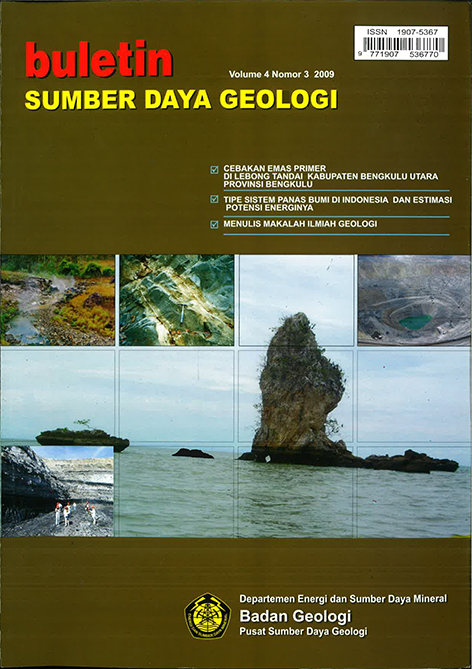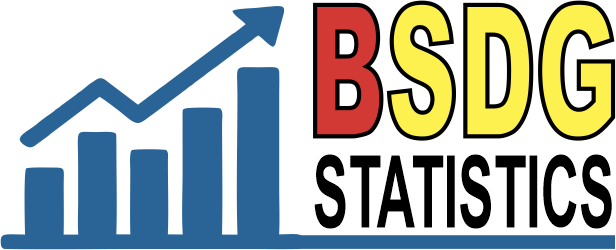TIPE SISTEM PANAS BUMI DI INDONESIA DAN ESTIMASI POTENSI ENERGINYA
Abstract
Indonesia memiliki potensi energi panas bumi yang sangat besar, sekitar 28
GWe, yang berada dalam berbagai tipe system panas bumi. Berdasarkan asosiasi lingkungan geologinya, Sistem panas bumi di Indonesia dapat di kelompokkan menjadi tiga tipe utama : vulkanik, vulkano tektonik dan non vulkanik. Tipe vulkanik dapat dibedakan lagi menjadi sistem tubuh gunung api strato, sistem komplek gunung api dan sistem kaldera sedangkan tipe vulkano tektonik pada umumnya merupakan perpaduan antara struktur depresi (graben) dan kerucut vulkanik. Pengelompokan sistem ini dapat memberikan gambaran atau estimasi awal besarnya potensi energinya. Tipe komplek vulkanik ataupun kaldera pada umumnya mempunyai potensi energi panas bumi yang jauh lebih besar daripada tipe-tipe lainnya.
Downloads
References
Badan Beologi, 2008. Potensi Energi Panas Bumi Indonesia
Ballard, R.D., 2000. Encyclopedia of Volcanoes, Academic Press, United
State.
Bodvarsson, G.S and Whiterspoon, P.A.,1989. Geothermal Reservoir
Engineering Part 1, Journal of Geothermal Sci. & Tech., Volume 2(1) pp. 1 – 68.
Bogie L, Lawless J.V, Rychargov S. And Belousov V. 2005. Magmatic-Related Hydrothermal Systems :Classification of the Types of Geothermal Systems and Their Ore Mineralization, World Geothermal Congress.
Edwards, L.M. 1982, Handbook of Geothermal Energy, Gulf Publishing
Company, Houston, United State.
Henley, RW and Ellis, AJ, 1983.Geothermal systems, ancient and
modern. Earth Science Reviews 19: 150
Hochstein and Browne, 2000. Surface Manifestations of Geothermal System with Volcanic Heat Sources, in Encyclopedia of Volcanoes.
Lawless, J.V., White, P.J., and Bogie, I.,1995. Tectonic features of Sumatra and New Zealand in relation to active and fossil hidrotermal systems: a comparison. Proceedings International Congress on Earth
Science, Exploration and mining around Pacifi c Rim. AIMM., p. 311-1316.
Peraturan Pemerintah No. 59 tahun 2007Tentang Kegiatan Usaha Panas Bumi
.
Standar Nasional SNI 18-6009-1999.Klasifikasi Potensi Energi Panas Bumi
di Indonesia, Badan Standardisasi Nasional.
Standar Nasional SNI 13-6171-1999 Metode Estimasi Potensi Energi Panas Bumi, Badan Standarisasi Nasional.
Tim BATM, 2003 , Kajian Penentuan Tarif Royalti Pengusahaan Sumberdaya Panas Bumi, Direktoraat Pengusahaan Mineral dan Batubara, ESDM.
Tim Survei Terpadu, 2007. Penyelidikan Terpadu Daerah Panas Bumi Wapsalit, Pulau Buru, Pusat Sumber Daya Geologi, Badan Geologi (Tidak
dipublikasikan)
Tim Survei Terpadu, 2007. Penyelidikan Terpadu Daerah Panas Bumi Bonjol,Sumatera Barat, Pusat Sumber Daya Geologi, Badan Geologi (Tidak dipublikasikan)
Tim Survei Terpadu, 2005. Penyelidikan Terpadu Daerah Panas Bumi Jaboi,Aceh, Pusat Sumber Daya Geologi,Badan Geologi (Tidak dipublikasikan)
Tim Pemboran Landaian Suhu, 2006. Pemboran Sumur Landaian Suhu Jaboi Daerah Panas Bumi Jaboi, Aceh, Pusat Sumber Daya Geologi, Badan Geologi (Tidak dipublikasikan)
Undang-Undang No. 27 Tahun 2003 Tentang Panas Bumi
Wohletz K. and Heiken G., 1992, Volcanology and Geothermal Energy,
University of California Press Oxford, Los Angeles, England.
Copyright (c) 2018 Buletin Sumber Daya Geologi

This work is licensed under a Creative Commons Attribution-NonCommercial-ShareAlike 4.0 International License.
Authors whose manuscripts are published agree to the following terms:
The publication rights of all journal manuscript materials published on the Buletin Sumber Daya Geologi website are held by the editorial board with the knowledge of the author (moral rights remain with the manuscript’s author).
The formal legal provisions for access to digital articles in this electronic journal are subject to the terms of the Creative Commons Attribution-ShareAlike (CC BY-SA) license. This means that Buletin Sumber Daya Geologi has the right to store, convert media/formats, manage in the form of a database, maintain, and publish the article without requesting permission from the author, as long as the author’s name is cited as the copyright holder.
Manuscripts published in both print and electronic formats are open access for educational, research, investigative, and library purposes. Beyond these purposes, the editorial board is not responsible for any violations of copyright law.















